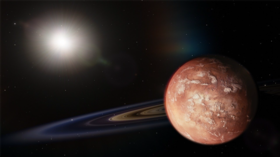Mars could develop its SECOND planetary ring in next 100mn years, claims wild new theory

Researchers have found yet more evidence that Mars once had its own Saturn-like planetary ring but, curiously, they now also believe that within the next 100 million years, The Red Planet will develop a ring once again.
Deimos, the smaller of the two Martian moons, orbits the planet with a slight tilt relative to the equator, an anomaly which could well be the result of a former planetary ring.
While most people instantly think of Saturn whenever a planetary ring is mentioned, they are actually relatively common, even within our own solar system; Uranus, Neptune, and Jupiter all have them.
As far back as 2017, researchers theorized that Mars too could once have boasted its own planetary ring, believed to have been formed following an asteroid impact which culminated in the formation of an earlier, more massive form of the planet's other moon, Phobos.
According to theoretical models, the remaining debris left behind after the asteroid strike formed a planetary ring.
"The fact that Deimos's orbit is not exactly in plane with Mars's equator was considered unimportant, and nobody cared to try to explain it," said astronomer Matija Cuk of the SETI Institute.
"But once we had a big new idea and we looked at it with new eyes, Deimos's orbital tilt revealed its big secret."
Also on rt.com ‘Mars is alive’: NASA’s InSight lander REVEALS Red Planet is seismically active worldDeimos' orbit is slightly off the Martian equator, an almost negligible amount but just about noticeable, and it swings around the planet roughly every 30 hours, with almost no eccentricity to its orbit.
However, Phobos was a different story altogether; it is closer to Mars with an orbit of just seven hours 39 minutes, and one that is shrinking at a rate of 1.8 centimeters (0.7 inches) per year.
In fact, the orbital decay is fast enough that scientists now estimate that within the next 100 million years, Phobos will reach the Roche limit or the point at which the planet's own gravitational forces tear the moon asunder.
Some of the resultant debris will likely rain down on the planet but the remainder could form yet another planetary ring and even reform into a smaller version of Phobos at the same time. The models predict that this new version of the moon would be repelled from the planet as the ring gets pulled in.
Using advanced simulations, Cuk and his team determined that an earlier version of Phobos, roughly 20 times the moon's current mass, would likely have caused Deimos' orbital tilt.
Also on rt.com Scientists develop hybrid reactor which can produce AIR and FOOD for future Mars colonies (PHOTOS)Thankfully, Cuk and his team of researchers will be able to test their theory, that Phobos in its current state likely formed around 200 million years ago, in the near future as the Japanese space agency, JAXA, has plans to send a probe to Phobos in 2024 to collect soil samples which can be dated back here on Earth to find out once and for all if the Red Planet did indeed have a planetary ring, and whether it might one day develop another one.
Think your friends would be interested? Share this story!














